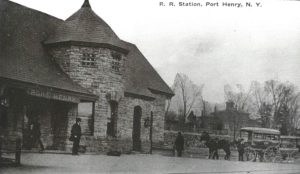Andebit et beaqui corendit, ut quostes esciendion re dit ad et prae parion es quia quas alibus sam, omnim faciden ducipidiat arum autem nobis enis es voat

25. The Railroads of Port Henry
Making Iron Transportation More Efficient
Listen to the Site 25 Iron Story Audio Narration
&nsbp;

The Delaware & Hudson Railroad Depot: This was another of George R. Sherman’s contributions to the community of Port Henry. The train depot was built in 1888. The Richardsonian-Romanesque style building includes arched windows, shingled gables, and an angled cupola. This style was quite popular in the United States at the time—and certainly with Sherman. You can see several other examples of this style around Port Henry. The depot was designed to impress visitors and reflects the economic boom that stemmed from developments in railroad transportation, which in turn spurred mining expansions. The railroad played a key role not only in expanding the iron business here, but it also boosted summer tourism in Port Henry. Today, it is home to a Senior Center and a working Amtrak Station.
By 1871, the first rail line ran between Ticonderoga and Port Henry—just three years later, the line was complete to Whitehall. A year later the entire route was open from Albany to Montreal. The train depot is still in use today for the Amtrak Adirondack line, connecting New York City to Montreal.
With the completion of through rail service from Albany to Canada by the Delaware & Hudson Company in 1875, railroad transportation supplemented the Champlain Canal as the southern shipping route for Moriah and Crown Point iron. The decision by Delaware & Hudson to extend the North-South railroad was obviously a financial one. Local iron mining was exhausting its charcoal supply and increasingly relying on Pennsylvania anthracite coal for fuel. The railroad company owned interests in coal mines in Pennsylvania as well as iron mining companies in Moriah. D&H purchased the Whitehall & Plattsburgh and Montreal & Plattsburgh rail lines and combined them into the New York & Canada Railroad. The slow, laborious job of hauling ore once done by John Flack Winslow’s and John A. Griswold’s Whitehall Towing Company could now be accomplished by train from Port Henry to Albany in a swift six to seven hours. Until the rail, the Whitehall Towing Company carried most of the iron produced in this area through the Champlain Canal.
By 1910, about three-fourths of ore shipment was done by rail, but with the opening of the 2,000-ton barge canal in 1913, canal boats again became the principal means for ore shipment. In 1916, a traveling cantilever bridge crane was constructed here. This crane, the largest of its kind in the world at that time, helped the loading of ore and furnace products onto the barges or into bins that feed the sintering plant. You can see the remains of the concrete trestle that once supported the steel crane.
The other railroad, built in 1868 by the Port Henry Iron Ore Company, was the Lake Champlain & Moriah Railroad. On the grounds, you can see several Lake Champlain & Moriah Railroad cars. The Moriah Plank Road had greatly improved the transporting of iron ore from the Moriah mines to the lakeshore furnaces and docks, but the mining companies needed a railroad. In 1868, Port Henry Iron Ore Company funded and began construction of the line. Many of the engines bore familiar names, like “Witherbee,” “G. Sherman,” “Cedar Point,” and “Adirondack.” When the Lake Champlain & Moriah Railroad replaced the Moriah Plank Road, the effect on mining operations was significant, reducing the cost per ton of ore shipped from 90 cents over the Moriah Plank Road to 32 cents per ton by rail.
The stone block walls on either side of the intersection of Route 9N and Park Place once supported the railroad bridge that guided the “Elsie and Em” around its final bend, behind Witherbee, Sherman and Company’s Port Henry Office, where remains of the bed can still be seen, and to its Cedar Point destination, where Witherbee, Sherman built a furnace in the 1870s.
Travel Tools
The Delaware & Hudson Railroad Depot (20 Park Place) is now an active Amtrak station, as well as a senior center. Park in the parking lot and explore.


